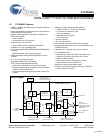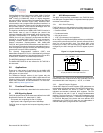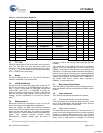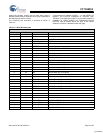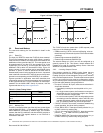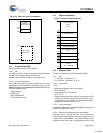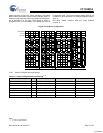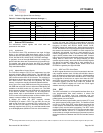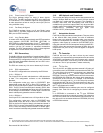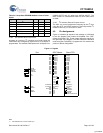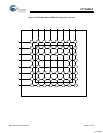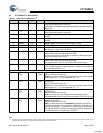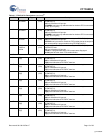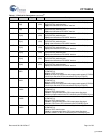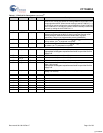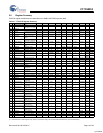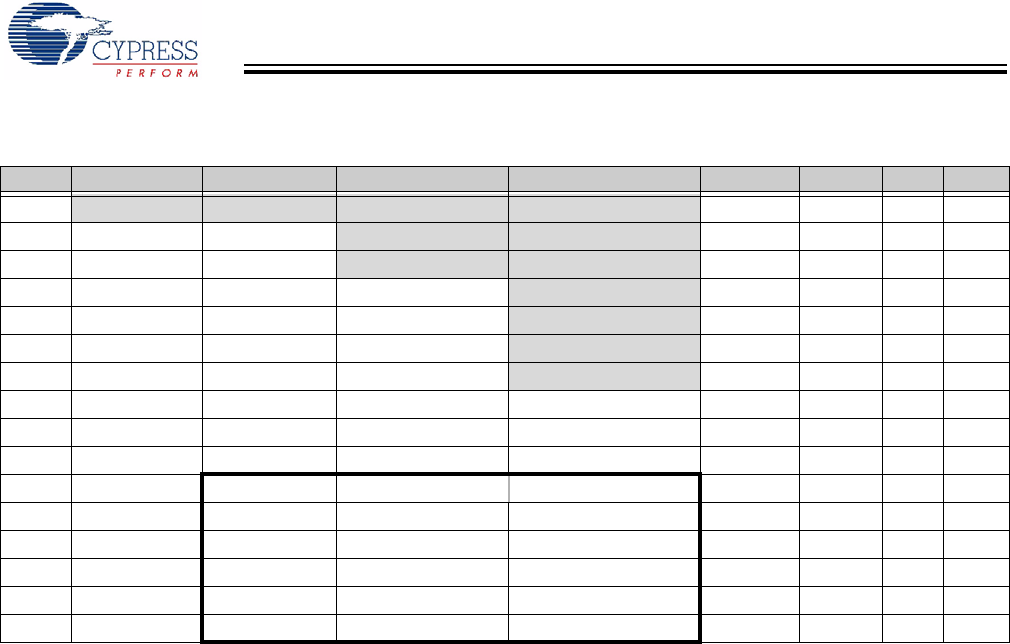
CY7C68053
Document # 001-06120 Rev *F Page 3 of 39
3.3 I
2
C™ Bus
FX2LP18 supports the I
2
C bus as a master only at 100-/400-
KHz. SCL and SDA pins have open-drain outputs and
hysteresis inputs. These signals must be pulled up to either
V
CC
or V
CC_IO
, even if no I
2
C device is connected.(Connecting
to V
CC_IO
may be more convenient.)
3.4 Buses
This 56-pin package has an 8- or 16-bit ‘FIFO’ bidirectional
data bus, multiplexed on IO ports B and D.
3.5 USB Boot Methods
During the power-up sequence, internal logic checks the I
2
C
port for the connection of an EEPROM whose first byte is
0xC2. If found, it boot-loads the EEPROM contents into
internal RAM (0xC2 load). If no EEPROM is present, an
external processor must emulate an I
2
C slave. The FX2LP18
does not enumerate using internally stored descriptors (for
example, Cypress’ VID/PID/DID is not used for enumer-
ation).
[1]
3.6 ReNumeration™
Because the FX2LP18’s configuration is soft, one chip can
take on the identities of multiple distinct USB devices.
When first plugged into USB, the FX2LP18 enumerates
automatically and downloads firmware and USB descriptor
tables over the USB cable. Next, the FX2LP18 enumerates
again, this time as a device defined by the downloaded infor-
mation. This patented two-step process, called
ReNumeration, happens instantly when the device is
plugged in, with no hint that the initial download step has
occurred.
Two control bits in the USBCS (USB Control and Status)
register control the ReNumeration process: DISCON and
RENUM. To simulate a USB disconnect, the firmware sets
DISCON to 1. To reconnect, the firmware clears DISCON to 0.
Before reconnecting, the firmware sets or clears the RENUM
bit to indicate whether the firmware or the Default USB Device
handles device requests over endpoint zero: if RENUM = 0,
the Default USB Device handles device requests; if
RENUM = 1, the firmware does.
3.7 Bus-powered Applications
The FX2LP18 fully supports bus-powered designs by enumer-
ating with less than 100 mA as required by the USB 2.0 speci-
fication.
3.8 Interrupt System
The FX2LP18 interrupts are described in this section.
3.8.1 INT2 Interrupt Request and Enable Registers
FX2LP18 implements an autovector feature for INT2. There
are 27 INT2 (USB) vectors. See the MoBL-USB™ Technical
Reference Manual (TRM) for more details.
3.8.2 USB Interrupt Autovectors
The main USB interrupt is shared by 27 interrupt sources. To
save the code and processing time that is normally required to
identify the individual USB interrupt source, the FX2LP18
provides a second level of interrupt vectoring, called ‘Autovec-
toring.’ When a USB interrupt is asserted, the FX2LP18
Table 3-1. Special Function Registers
x 8x 9x Ax Bx Cx Dx Ex Fx
0
IOA IOB IOC IOD SCON1 PSW ACC B
1SP EXIF
INT2CLR IOE SBUF1
2DPL0 MPAGE OEA
3DPH0
OEB
4 DPL1
OEC
5 DPH1 OED
6 DPS
OEE
7PCON
8 TCON SCON0 IE IP T2CON EICON EIE EIP
9TMOD SBUF0
ATL0AUTOPTRH1 EP2468STAT EP01STAT RCAP2L
BTL1AUTOPTRL1 EP24FIFOFLGS GPIFTRIG RCAP2H
CTH0Reserved EP68FIFOFLGS TL2
DTH1AUTOPTRH2 GPIFSGLDATH TH2
E CKCON AUTOPTRL2 GPIFSGLDATLX
F Reserved AUTOPTRSET-UP GPIFSGLDATLNOX
Note
1. The I
2
C bus SCL and SDA pins must be pulled up, even if an EEPROM is not connected. Otherwise this detection method does not work properly.
[+] Feedback



